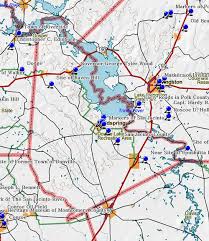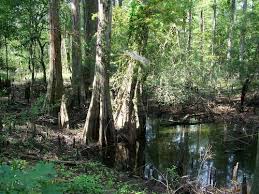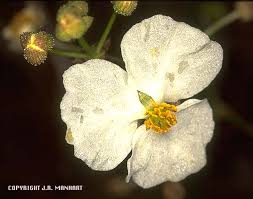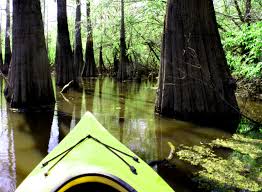For "Travel Tuesday", let's go to East Texas to the Big Thicket, which spans several counties.
Big Thicket National Preserve, Texas 
"With approximately 100,000 acres of dense vegetation and diverse wildlife in Southeast Texas, Big Thicket National Preserve is the perfect destination for the wild at heart. The preserve features an unusual mix of ecosystems spread across 15 park units in seven counties. Its diverse habitats, which range from sand hills to swamps, host a wide array of wildlife, including 60 mammals, 90 reptiles and amphibians, and more than 170 birds. Big Thicket's resources are particularly vulnerable to adjacent development because most of the preserve's units are small and isolated from one another. But one recently acquired section of the park helps extend and protect critical habitat: The new 6,600-acre Lower Cypress Tract of the Beaumont Unit is the only coastal wetlands environment in the preserve and serves as a crucial filtration system and breeding ground for many native animals, such as the American alligator, blue crab, and roseate spoonbill. It also provides a necessary buffer zone against flooding and erosion. NPCA is currently working with Lamar University to provide educational field trips to the new tract for students.
If you go > >
The preserve only has eight official hiking trails, varying from half a mile to 18 miles long, and some of these trails close for hunting season (October 1 to February 1). Paddling on rivers and creeks can be another exciting way to explore areas of the park that are too wild for footpaths."
View the slideshow > >
___________
Big Thicket National Preserve

"Adventure, wildlife and fun await you at the Big Thicket National Preserve.
The Big Thicket National Preserve was established by Congress in 1974. This combination of virgin pine and cypress forest, hardwood forest, meadow and blackwater swamp is managed by the National Park Service. The Preserve was established to protect the remnant of its complex biological diversity. What is so extraordinary is not the rarity or abundance of its life forms, but how many species coexist here.
Major North American biological influences bump up against each other here: southeastern swamps, Appalachians, eastern forests, central plains, and southwest deserts. Bogs sit near arid sandhills. Eastern bluebirds nest near roadrunners. There are 85 tree species, more than 60 shrubs, and nearly 1,000 other flowering plants, including 26 ferns and allies, 20 orchids and four of North America's five type of insect-eating plants. Nearly 300 kinds of birds live here or migrate through. Fifty reptile species include a small, rarely seen population of alligators. Amphibious frogs and toads abound.
 Activities in the Big Thicket National Preserve include hiking, camping, bicycling, horseback riding, canoeing, birdwatching, fishing and more. Visitors find the Big Thicket to be a fun, educational trip for the entire family."
Activities in the Big Thicket National Preserve include hiking, camping, bicycling, horseback riding, canoeing, birdwatching, fishing and more. Visitors find the Big Thicket to be a fun, educational trip for the entire family."
To find out more, visit the official
Big Thicket National Preserve Website
____________
- "One's fondness for the area is hard to explain. It has no commanding peak or awesome gorge, no topographical feature of distinction. Its appeal is more subtle." - Big Thicket Legacy, University of Texas Press, 1977.
"Historical limits of the Big Thicket region prior to the Texas Revolution. Deforestation has dramatically reduced its size.
The Big Thicket is the name of a heavily forested area in Southeast Texas. While no exact boundaries exist, the area occupies much of Hardin County, Liberty, Tyler, San Jacinto, and Polk Counties and is roughly bounded by the San Jacinto River, Neches River, and Pine Island Bayou. To the north, it blends into the larger Piney Woods terrestrial ecoregion of which it is a part. It has historically been the most dense forest region in what is now Texas, though logging in the 19th and 20th centuries dramatically reduced the forest concentration.
The terrain in the Big Thicket is unremarkable and offers none of the impressive views that can be found in many other National Parks and Preserves. The area lies on the flat coastal plain of Texas, and is crossed by numerous small streams. The extent of the region was once much larger than today covering more than 2 million acres (8,100 km2) in east Texas. The Spaniards, who once ruled the region, defined its boundaries in the north as El Camino Real de los Tejas, a trail that ran from central Texas to Nacogdoches; in the south as La Bahia Road or Atascosito Road, a trail that ran from southwest Louisiana into southeast Texas west of Galveston Bay; to the west by the Brazos River; and to the east by the Sabine River. Timber harvesting in the 19th and 20th centuries dramatically reduced the extent of the dense woodlands.
The Big Thicket's geographical features are believed to have their origins with the Western Interior Seaway, an inland sea that covered much of North America during the Cretaceous period. Over time, water smoothed out the land along what is now Texas's coastline." From: http://en.wikipedia.org/wiki/Big_Thicket
______________
Some pictures of the Big Thicket.
_____________
The History of the Big Thicket, this is just a sample:
"The federal government established the Big Thicket National Preserve in twelve different units in Polk and Tyler counties and the counties to their south. The old people and old families, however, who have always known that they lived in the Big Thicket, define it as a much smaller area. This is frequently called the bear hunters' thicket.
This traditional Big Thicket–the bear hunters' thicket–is about forty miles long and twenty miles across at its widest. It is flat land, grey clay and sand, part of the Pine Island Bayou drainage system. It is a thickly wooded area that begins in the southern parts of Polk and Tyler counties, where the creeks flow out of the red dirt hills. It ends in the south below Sour Lake, where the dense woods thin out in stands of pine and in the rice farms of the coastal prairie. The eastern and western boundaries were easier to define in the old days before the loggers got hold of it, but east of Cypress Creek the elevation is higher, the land is sandy, and there used to be great climax stands of yellow pine five and six feet in diameter. The western boundary of the thicket was marked by big open pine stands along the spoil banks of the Trinity River and by Batson Prairie on the southwest. Before the incursion of the lumber and oil industries, this heart of the thicket was characterized by dense vegetation and by large numbers of deer, bear, panthers, and wolves, as well as the common varieties of mammals, birds, reptiles, and amphibians."
More interesting facts about the Spaniards and Indians at Big Thicket at: http://www.tshaonline.org/handbook/online/articles/gkb03
_____________
On This Day:
Earthquake rocks Alaska, Mar 27, 1964:
"The strongest earthquake in American history, measuring 8.4 on the Richter scale, slams southern Alaska, creating a deadly tsunami. Some 125 people were killed and thousands injured."
_____________
Fingerprint evidence is used to solve a British murder case, Mar 27, 1905:
"The neighbors of Thomas and Ann Farrow, shopkeepers in South London, discover their badly bludgeoned bodies in their home. Thomas was already dead, but Ann was still breathing. She died four days later without ever having regained consciousness. The brutal crime was solved using the newly developed fingerprinting technique. Only three years earlier, the first English court had admitted fingerprint evidence in a petty theft case. The Farrow case was the first time that the cutting-edge technology was used in a high-profile murder case.
Since the cash box in which the Farrow's stored their cash receipts was empty, it was clear to Scotland Yard investigators that robbery was the motive for the crime. One print on the box did not match the victims or any of the still-tiny file of criminal prints that Scotland Yard possessed. Fortunately, a local milkman reported seeing two young men in the vicinity of the Farrow house on the day of the murders. Soon identified as brothers Alfred and Albert Stratton, the police began interviewing their friends.
Alfred's girlfriend told police that he had given away his coat the day and changed the color of his shoes the day after the murders. A week later, authorities finally caught up with the Stratton brothers and fingerprinted them. Alfred's right thumb was a perfect match for the print on the Farrow's cash box.
The fingerprint evidence became the prosecution's only solid evidence when the milkman was unable to positively identify the Strattons. The defense put up expert Dr. John Garson to attack the reliability of the fingerprint evidence. But the prosecution countered with evidence that Garson had written to both the defense and prosecution on the same day offering his services to both.
The Stratton brothers, obviously not helped by the discrediting of Garson, were convicted and hanged on May 23, 1905. Since then, fingerprint evidence has become commonplace in criminal trials and the lack of it is even used by defense attorneys."
___________
March Madness is born, Mar 27, 1939:
"The University of Oregon defeats The Ohio State University 46–33 on this day in 1939 to win the first-ever NCAA men’s basketball tournament. The Final Four, as the tournament became known, has grown exponentially in size and popularity since 1939. By 2005, college basketball had become the most popular sporting event among gamblers, after the Super Bowl. The majority of that betting takes place at tournament time, when Las Vegas, the internet and office pools around the country see action from sports enthusiasts and once-a-year gamblers alike.
For the first 12 years of the men’s tournament, only eight teams were invited to participate. That number grew steadily until a 65-team tournament format was unveiled in 2001. After a "play-in" game between the 64th and 65th seeds, the tournament breaks into four regions of 16 teams. The winning teams from those regions comprise the Final Four, who meet in that year’s host city to decide the championship.
The most successful team in NCAA men’s tournament history has been the UCLA Bruins, who have taken home a record 11 championships, 10 of them under legendary coach John Wooden between 1964 and 1975. The University of Kentucky is second with seven titles and Indiana University rounds out the top three with five tournament wins. At the end of every tournament, a Most Outstanding Player is chosen. Almost all of these players go on to productive careers in the NBA. Lew Alcindor, later Kareem Abdul-Jabbar, won the award three times while leading UCLA to three national championships in 1967, 1968 and 1969. Bill Walton, who succeeded Alcindor at center for UCLA, Jerry Lucas of Ohio State, Alex Groza of Kentucky and Bob Kurland of Oklahoma A&M all won the award twice.
The NCAA held its first women’s basketball tournament in 1982. The women’s tournament started with 32 teams, expanding to 64 teams before the 1994 season. Today, the women’s format echoes the men’s, with play in four regions culminating in a Final Four held in a single location. The championship is played the day after the men’s, concluding the college basketball season. The most dominant team in women’s tournament history has been the Tennessee Volunteers, who won six championships under renowned coach Pat Summit from 1973 to 2006. The Connecticut Huskies are second, with five championships under coach Geno Auriemma. Past women’s Most Outstanding Player winners include Cheryl Miller of USC, Diana Taurasi of Connecticut and Chamique Holdsclaw of Tennessee; all went on to become stars of the WNBA."
---------------
Another thought about March Madness:
Transcript at: http://www.ucg.org/beyond-today-daily/christian-living/march-madness-spiritual-connection
______________
Yesterday:
Mindi's 6 dogs were still here, and four of them needed some help with their coiffure. Her husband had given them all baths the day before, but he hadn't brush-dried the poodles. The Yorkie, "Puddin'", is his, and she needed her feet trimmed and bangs cut so that she could see where she was going. The 3 poodles were straggly as Mindi hadn't clipped their faces for a long time. So while Ray sanded, primed and painted the trim and gutter that we had removed from the cargo trailer, I trimmed those four dogs. Not a full groom, there wasn't the time to do that, so I gave each of them a quick "Face, Feet and Tail", and gave them a good brushing so they looked fluffy. Actually that took all day, then I cut all 6 dog's nails.
Ray and I put some Eternabond over the offending leaky screw hole in the corner of the rubber roof, and some more on back of the gutter, so that the screws would be self-sealing when we re-installed it. Then it was time for Ray to leave.
I was pretty beat when Mindi came to pick up the dogs, but she loved how they looked. It was a lovely sunny, window-and-doors-open day.































1 comment:
The Big Thicket is a great place to visit.
Post a Comment